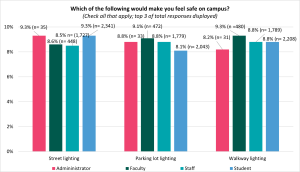Next Steps and Recommendations
Next Steps and Recommendations
This study provides a current baseline for understanding the campus climate at Carolina. The survey results do not contain responses from all the community members or cover all issues that may assist in us understanding out community more completely. This executive summary isa reference for the University in its quest for inclusive excellence. It is important to continue the longstanding efforts of commitment to creating a diverse and inclusive community with a history of excellence in research, teaching, and public service. Several key takeaways from these findings include the following.
- Addressing and Supporting Faculty Perspectives – In several instances, faculty responses diverged from administrators, staff, and students by several percentage points. For example, faculty were the least likely to indicate that UNC-Chapel Hill promotes racial or cultural interaction between different groups; that it provides programming that fosters a welcoming and inclusive community; or that they would recommend the University to others considering working here. The development of more faculty affairs programs to address areas of concern could remedy some differences observed across the surveyed populations. Further, additional inquiry could illuminate important contextual factors to be considered in building-out programming and support.
- Improve our Understanding of Diversity and Inclusion – While most respondents within the four surveyed populations agreed UNC-Chapel Hill is diverse and inclusive, room for improvement does seem possible given differences that appeared by sub-populations. In particular, it is important to understand why various populations characterize diversity and inclusion in specific ways; what diverse and inclusive environments look like to individuals; and how results compare to past surveys or peer institutions. Answers to these questions about the unique elements of diversity and inclusion within populations might inform efforts to improve experiences for all members of our community.
- Working to Improve Feelings of Safety – The data showed that several populations feel less safe on and off campus than peers. Respondents were given the opportunity to provide insight about 13 safety measures that would make them feel safe on campus that might be starting points. Across all community members, the top three most frequent responses to improve safety included: street lighting, parking lot lighting, and walkway lighting; see Appendix Tables C.1-3 to see full list of response choices and view top selections of employees and students by gender identities, race/ethnicities, and sexual identities/orientations. In addition to understanding the variation in preferred safety measures, a more detailed understanding of the contexts in which individuals feel safe might allow us to better meet our community’s needs.

Continuing the exploration of the survey data and other forms of community input will help to identify areas for growth, change and enhancement. The active engagement of members of the Carolina community in contributing to our knowledge of their experiences is critical to the success of these ongoing efforts.

